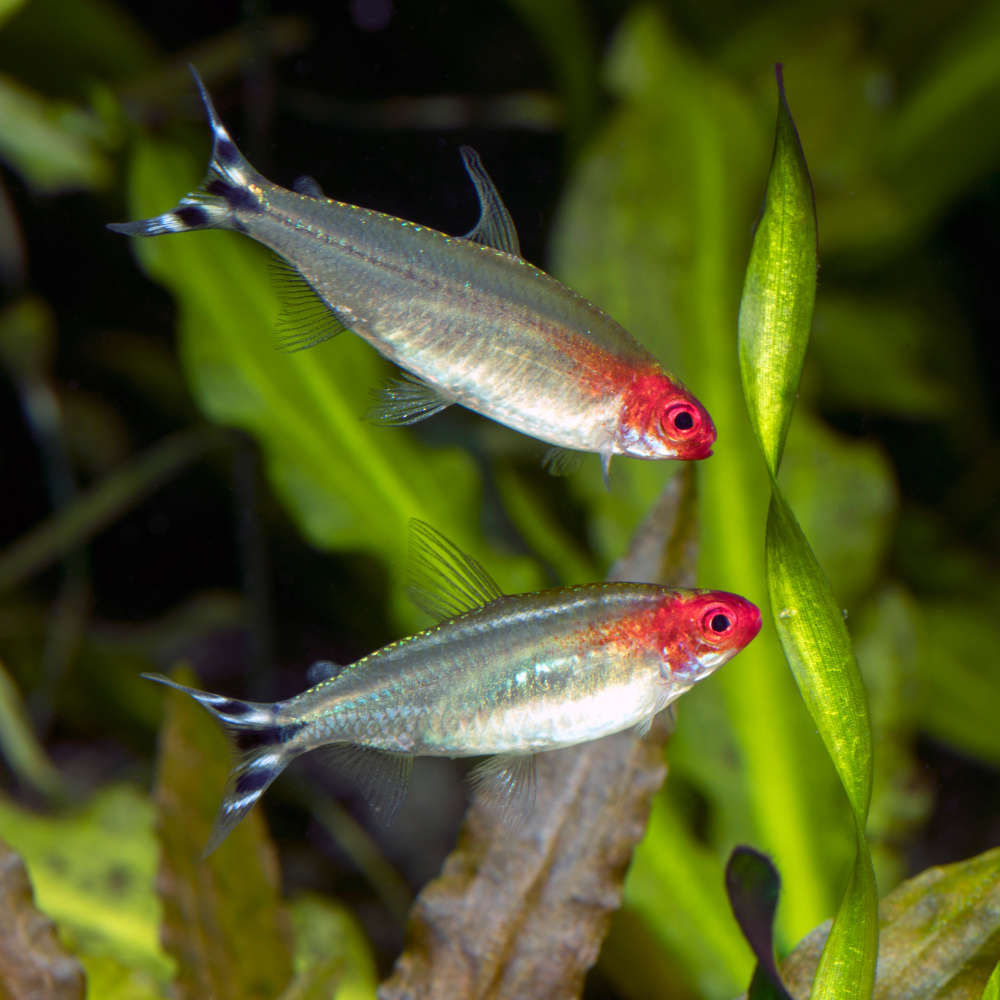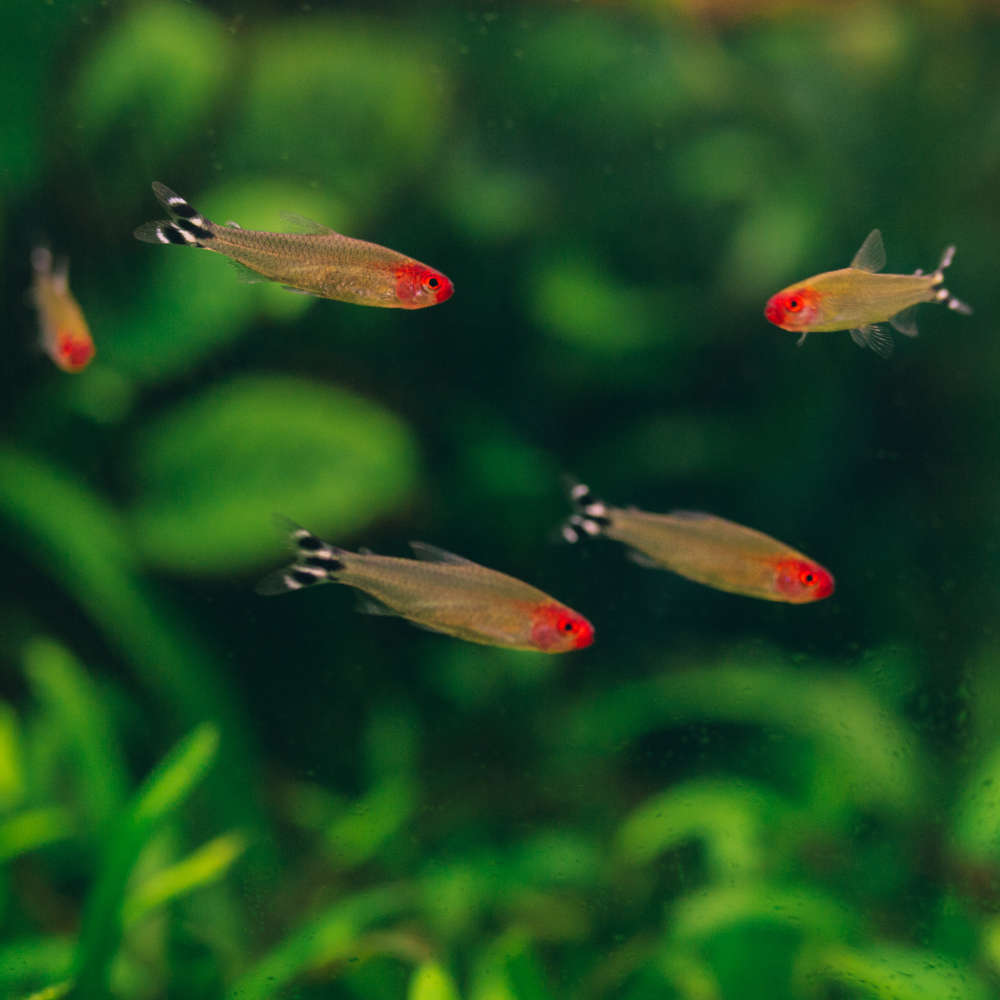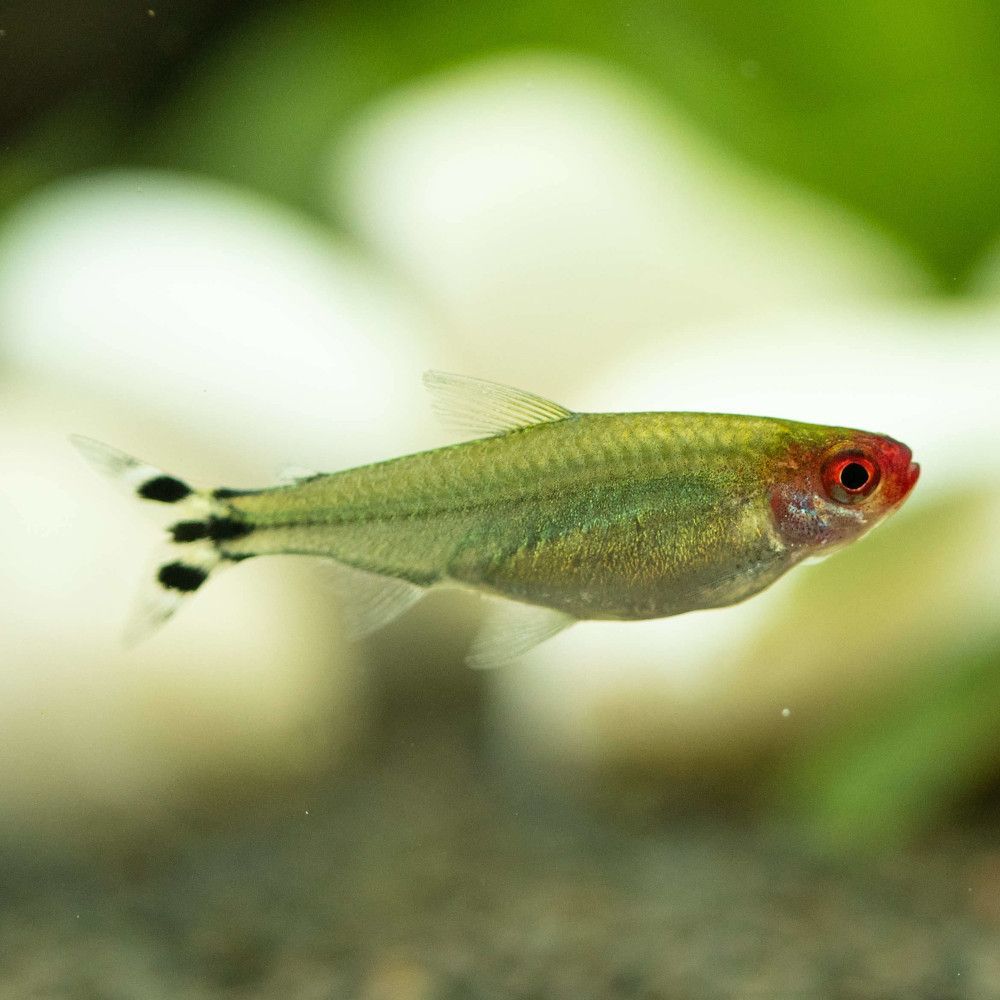If you want a subtle-colored fish for your freshwater tank, the rummy nose tetra will steal the show. This neat-looking species is loved by aquarists for accepting all kinds of food without any fuss.
The schooling fish is usually easy to care for with basic maintenance. It’s also great for community tanks due to its mellow nature.
Now, if you’re eager to bring this fish home, let’s know how to care for it here…
What is a Rummy Nose Tetra Fish?
| Origin | Orinoco and lower Amazon River basins, South America |
| Order | Characiformes |
| Family | Characidae |
| Scientific Name | Hemigrammus rhodostomus |
| Common Names | Red-nosed tetra |
| IUCN Red List Status | Least Concern |
| Appearance | Elongated body, red nose, silver body, transparent fins, forked tail with black and white stripes |
| Size (Adult) | Up to 5 cm (2 in) |
| Lifespan | Up to 5 years |
| Temperament | Peaceful |
| Tank Level | Middle and bottom-dwellers |
| Water Temperature | 72-82 °F (22-28 °C) |
| pH Level | 5.5-7 |
| Water Hardness | Up to 10 dGH |
| Care Level | Easy to Moderate |
| Minimum Tank Size | 30 gallons for 10 fish |
| Tank Environment | Planted, sandy substrate, dimly lit, lots of swimming space, and slow current |
| Diet | Omnivorous |
| Tank Mates | Own school, other similar-sized and similar-tempered species |
Where can you find a Rummy Nose Tetra Fish?
The rummy nose tetra is native to the Orinoco River basins and the lower Amazon River basins in Brazil and Venezuela, South America.
It’s found in the blackwater rivers and tributaries stained brown from tannings of decaying organic matter.
According to the 2018 assessment of The IUCN Red List of Threatened Species, it’s given the Least Concern status.
What is the family of Rummy Nose Tetra Fish?
The tetra belongs to the order Characiformes and the family Characidae. Its binomial name is Hemigrammus rhodostomus, and worldwide, it’s known as – red-nose tetra or red-nosed tetra.
Fun Fact: The red tint of the rummy nose tetra may turn dull when it’s sick, stressed, or when the tank water is contaminated. Thus, it’s called the “canary of the coal mine” of aquariums.
How does Rummy Nose Tetra Fish Look?

If you’re curious about the looks and attitude of this little one, let’s head right into it.
What is the Size of Rummy Nose Tetra Fish?
Rummy nose tetra grows to be around 3.8 – 5 cm (1.5-2 in).
What is the Color of Rummy Nose Tetra Fish?
The rummy nose tetra has a silver body that reflects neon highlights in the right lighting. It has a bright red nose, which led to its name. The tail fin is striped with three wide black and four thin white stripes, and the other fins are transparent.
It’s often said that there are three types of rummy nose tetra – but they are all different species:
- “True” rummy nose tetra (Hemigrammus rhodostomus): Red stays only around the head. No dark line extending from tail to body. Dark blotch on both the top and bottom of the caudal peduncle.
- Firehead tetra (Hemigrammus bleheri): Red bleeds beyond its gill covers. A narrow dark line extending from tail to body. Dark blotch on both the top and bottom of the caudal peduncle.
- False rummy nose tetra (Petitella georgiae): Red is lighter and stays only around the head. A broad dark line extending from tail to body. Dark blotch on only top of caudal peduncle.
What are the Features of Rummy Nose Tetra Fish?
This tetra has an elongated full-body shape.
How is a male and a female Rummy Nose Tetra Fish different?
The mature female rummy nose tetra is rounder than the male fish. This difference is obvious, especially during mating season.
During the spawning season, the red tinge of the male intensifies much more. This is to attract potential mates and establish dominance in the group.
But unless you’re experienced in dealing with this species, it’s challenging to notice such minute differences.
What is the behavior of Rummy Nose Tetra Fish?
Rummy nose tetra is quite peaceful and timid. The schooling fish feels stressed from active, large, or boisterous species. It feels more confident when kept in a big school and with similar-tempered species.
What is the Lifespan of Rummy Nose Tetra Fish?
The rummy nose tetra lives up to 3-5 years on average. In my experience, it can also live up to 6 years with optimal care.
Author’s Note: The tetra gets scared by loud noises and excess movements outside its tank. So, place your rummy nose tetra tank somewhere with low noise and activity.
How to take care of Rummy Nose Tetra Fish?

If you plan to bring a group of this bubbly cute tetra home, you must prepare the perfect environment for them. So, first, let’s start with…
What is the Tank Size of Rummy Nose Tetra Fish?
Some may suggest putting six rummy noses in 20 gallons. However, the fish is happier in bigger schools. In the wild, it forms schools of 6 to even 32. So, get at least 10 of them and prepare a 30-gallon tank to house them.
However, if you want a community tank or have a bigger school, go for a bigger tank.
What is the Water Chemistry required for Rummy Nose Tetra Fish?
The tetra’s life and overall health depend a lot on the water quality. So, it’s important to follow these water parameters strictly.
- pH Levels: 5.5-7
- Water Temperature: 72-82 °F (22-28 °C)
- Water Hardness: Up to 10 dGH
- Ammonia: 0 ppm
- Nitrite: 0 ppm
- Nitrate: Less than 20 ppm
What is the Tank Environment for Rummy Nose Tetra Fish?
Other than that, here are a few other details that you must be cautious about:
Which Substrate does Rummy Nose Tetra Fish need?
The rummy nose tetra feels more comfortable in a fine-grained soft river sand substrate. This resembles the species’ natural habitat the most. Since the fish sometimes swims in the bottom of the tank, this substrate will protect its body and fins from getting scratched.
Don’t use gravel as it’s coarse for the fish body.
Which Plants do Rummy Nose Tetra Fish need?
Choose some plants that can grow tall enough to reach the middle column of the tank. This provides shelter to your pet fish. Some options are Java fern and Amazon sword.
However, make sure you keep the center of the tank clear to provide enough swimming space for your fish.
Which Lighting does Rummy Nose Tetra Fish need?
Go for subdued lighting to encourage the rummy nose to swim around actively. You can add some floating plants to ensure extra shade from lights. Keep the tank away from direct sunlight.
Which Décor does Rummy Nose Tetra Fish need?
The best decor options for this tetra’s tank are driftwood, thoroughly dried and debarked common beech, twisted roots, and dried beech or oak leaves. These stain the water to mimic the natural water of the species.
Replace old leaves, roots, and branches before they rot to avoid affecting the tank water chemistry.
You can also add small rocks, caves, and PVC pipes as hiding spots.
What type of Filter does Rummy Nose Tetra Fish need?
As the tetra is sensitive to water quality, a strong and efficient filtration, like an external filter or under-gravel filter, is necessary.
Additionally, put aquarium-safe peat into the filter to mimic blackwater conditions. Perform 30% water changes weekly.
What is the Water Flow Rate for Rummy Nose Tetra Fish?
Similar to its native waters, maintain a still or slow water flow in the tank. The tetra isn’t strong enough to swim against currents.
Care Tip: When taken home from store to home, the fish may act dead in the fish bag. But don’t worry; once you set the bag on a solid surface, the fish will become active again.
What food does Rummy Nose Tetra Fish eat?
The rummy nose tetra is a voracious omnivore that lives on filamentous algae, microcrustaceans, insects, seeds, insect and fish eggs, and detritus in the wild.
In captivity, the little fish shows its brightest colors when fed a varied diet with a mixture of dry, live, and frozen feed like the following:
- Dried flakes and granules
- Vegetables (Skinned peas, cucumber, spinach)
- Fruits
- Brine shrimp
- Cyclops
- Fruit flies
- Daphnia
- Mosquito larvae
- Detritus worm
- Moina
- Grindal worm
- Bloodworm
- Blackworm
- Tubifex worm
- Vinegar eel
The fish has a small mouth, so make sure you chop its food into small pieces. Provide meals twice a day for 2-3 minutes each. Remove excess leftovers afterward.
Feed live and frozen feed only 1-2 times a week. The remaining meals must be on flakes, pellets, and vegetables.
What are the Tank Mates for Rummy Nose Tetra Fish?
Ensure you have 10 rummy nose tetras before getting other tank mates. Once that’s done, you can pick some other peaceful, shy, and similar-sized species like:
- Celestial pearl danio
- Small tetras (neon tetra, green neon, ember tetra, glowlight, black neon, cardinal tetra)
- Molly
- Cory catfish
- Otocinclus catfish
- Yo-yo loach
- Hatchetfish
- Harlequin rasbora
- Cherry barb
- Gourami (dwarf, sparkling, pearl gourami)
- Bristlenose pleco
- Guppy
- Platy
- Endler’s livebearer
- White cloud mountain minnow
- Snail
- Shrimp
Which Tank Mates to Avoid with Rummy Nose Tetra Fish?
Always avoid the following kinds of fish in your rummy nose tank:
- Large fish/fish with large mouths: They’ll eat your rummy nose.
- Aggressive/predatory species: They’ll also eat or harass your tetra.
- Long-finned species: The tetra might want to nip their fins.
These species include:
- Freshwater angelfish
- Aggressive cichlid
- Betta
What are the Diseases in Rummy Nose Tetra Fish?
Rummy nose tetra are sensitive to stress and fall sick, especially to common bacterial and parasitic infections like the following:
| Disease Name | Causes | Symptoms | Treatment |
|---|---|---|---|
| Dropsy | Infection, stress, polluted water | Swollen abdomen, scale protrusion, skin redness around fins and vents, ulcers | Quarantine, enhance diet, perform partial water changes regularly, add medicine |
| Ich | External protozoan parasite | Poor appetite, fatigue, white spots, flashing | Add ich medicines, increase water temperature |
| Columnaris | Bacterial infection | Poor appetite, fatigue, gray/white patches, fin fraying | Improve water quality, antibiotics, reduce stress |
Quick Tip: Always quarantine the diseased fish and treat them with broad-spectrum medicines.
How to Breed Rummy Nose Tetra Fish?
Breeding rummy noses is not easy, but the right setup and conditions can help. So, follow these steps to get a healthy brood:
1. Breeding Tank Setup
Prepare a separate 30-gallon tank with dim lights, spawning mops, and fine-leaved plants like Java moss for egg deposition. You can also add a mesh at the bottom of the tank to pass the eggs through it but not the parent fish.
Maintain water chemistry:
- Water Temperature: 80-86 °F (27-30 °C)
- Water Hardness: 1-5 dGH
- pH Levels: 5.5-6.5
Install a small air-powered sponge filter. Filter the water through peat and use RO water. Fill the tank with water until it reaches 15 cm of height (6 in).
2. Group Choosing & Conditioning
It’s difficult to differentiate rummy noses sexually. So, get a group of 10-12 to ensure that you have both genders. Choose sexually mature specimens that are at least 1 inch long or 12 months old.
If you have a bigger school in the main tank, put them in separate gender-based tanks. In the male-only tank, put the ones with the brightest noses. In the female-only tank, put the fattest fish of the lot.
Feed the group plenty of live food. Now, choose 5-6 brightest-nosed and fattest specimens from respective tanks and introduce them to the breeding tank.
3. Mating
These fish mate mostly around evenings to mornings. If the perfect conditions are maintained, the female lays her eggs on plants, and the male scatters his milt.
Remove the parent fish group once you spot eggs; otherwise, they’ll eat the eggs or newborn fry.
4. Incubation & Fry Development
Keep the lights out in your tank, as the eggs and fry are light-sensitive. Eggs hatch in 24-36 hours; the fry lives on their egg yolk for a while. After 2-4 days, the fry becomes free swimmers.
Feed the fry infusoria until they’re old enough to consume larger food. Introduce microworms and baby brine shrimp afterward.
Breeding Tip: You may try breeding in pairs if you’re able to distinguish the fish sexually.
How to Buy Rummy Nose Tetra Fish?
Look for these signs of good health while choosing a group of rummy nose tetra:
- Slightly round belly
- Actively swimming around
- Red noses – a pale nose implies the fish has been recently transported or got chased with nets. Check in the next day to see if the red color returns.
- No white spots
- Intact fins
A word from FishInAquarium
The sight of a group of rummy nose tetras swimming around in your aquarium is bound to leave you hypnotized for hours.
With the right lighting, they reflect various colors, which makes them appear like twinkling stars.
If this guide helped you know better about this fish, share it with other enthusiasts. However, if there are more questions, send us an email and we’ll help you to the best of our abilities!


